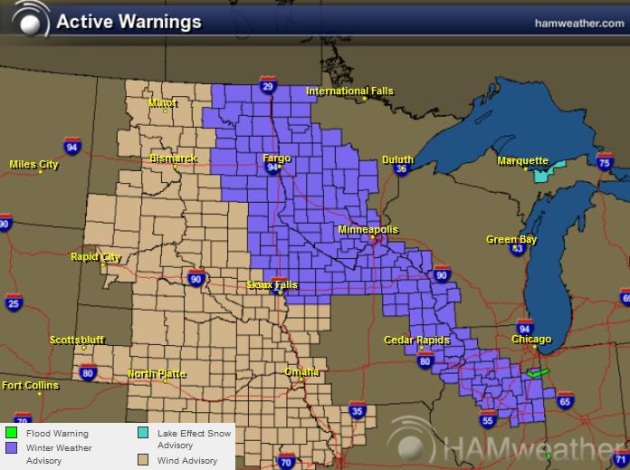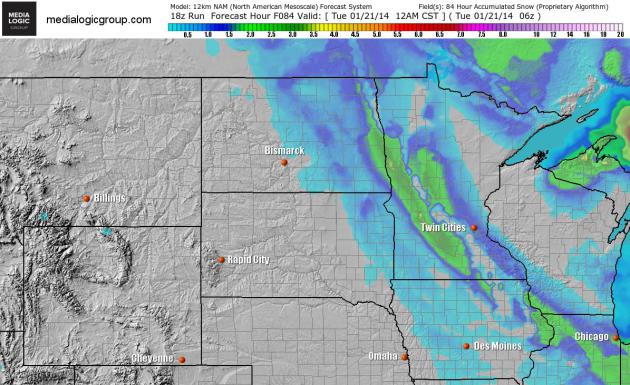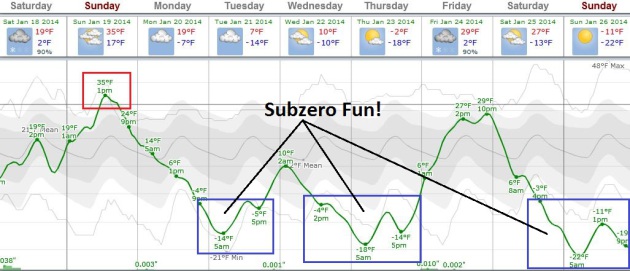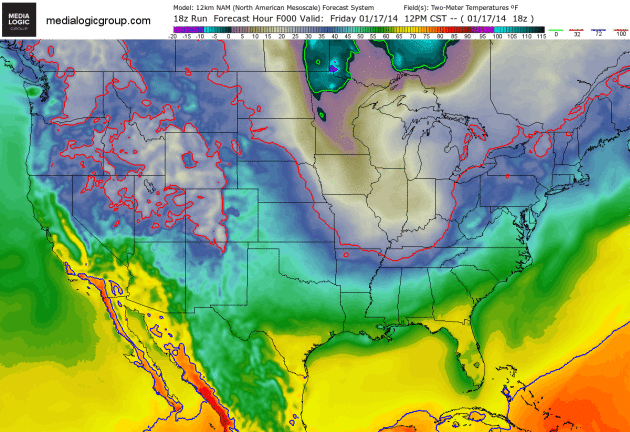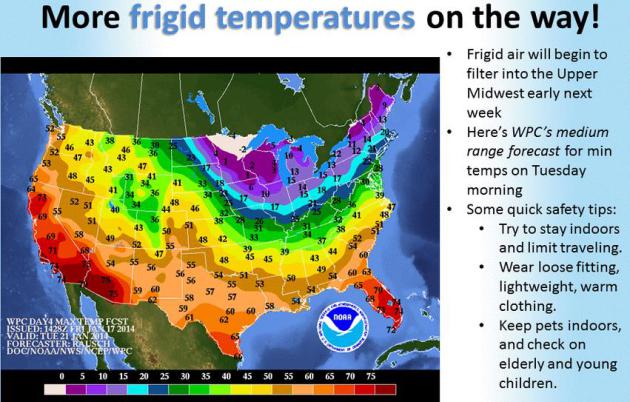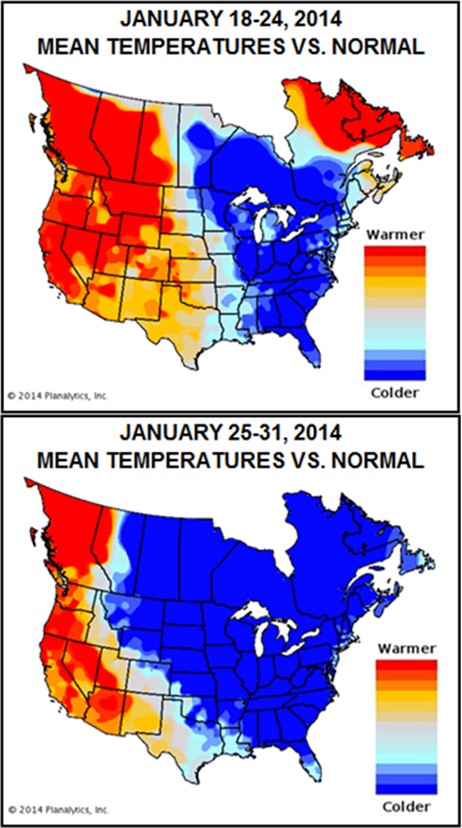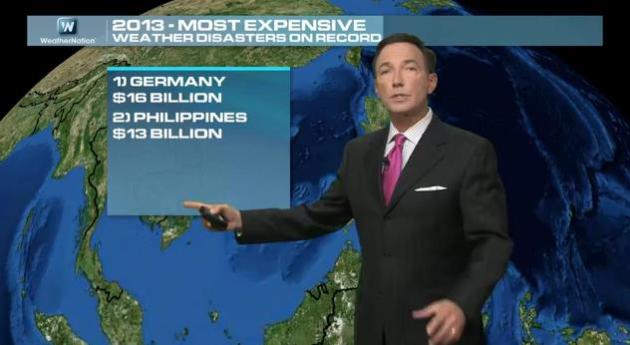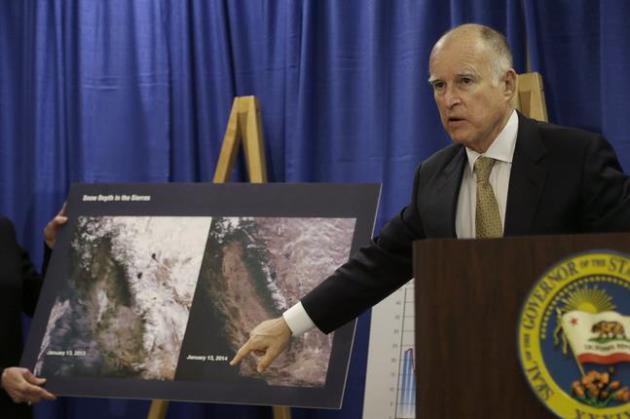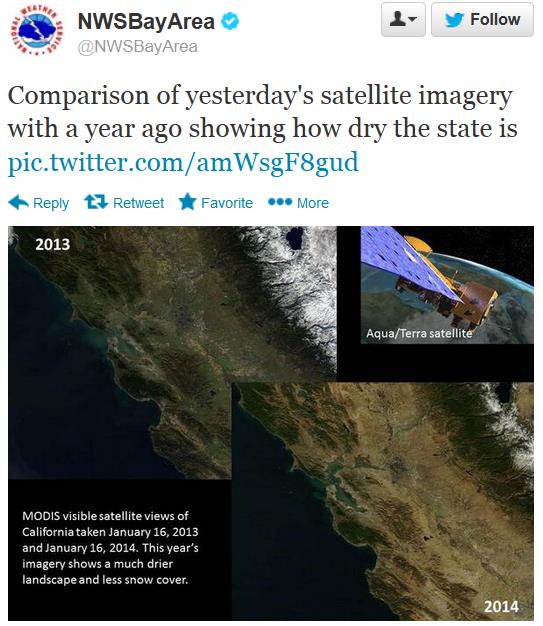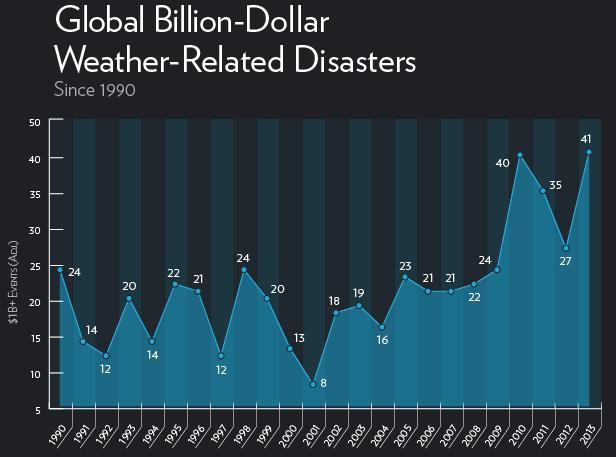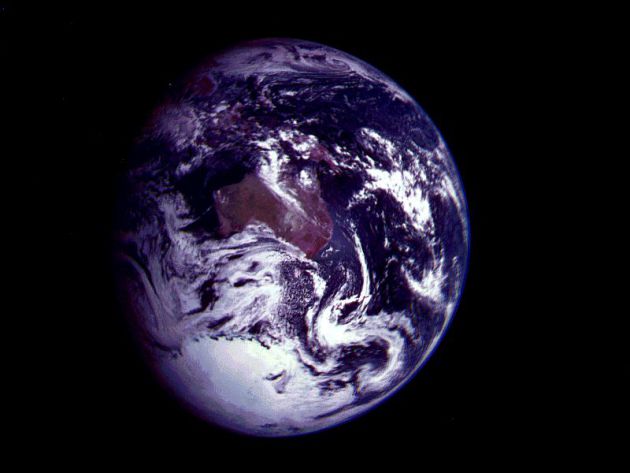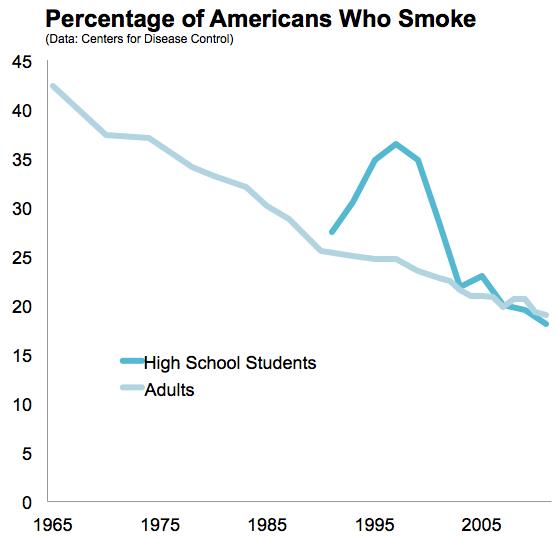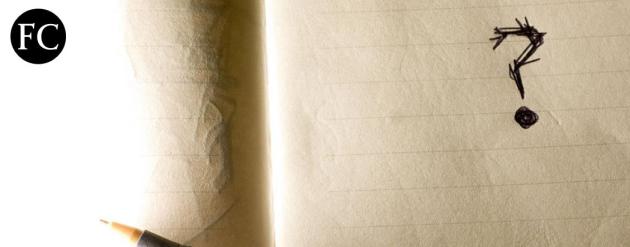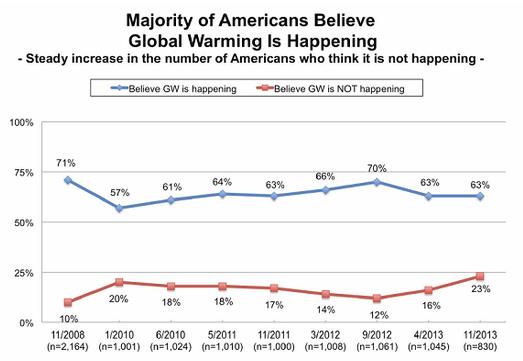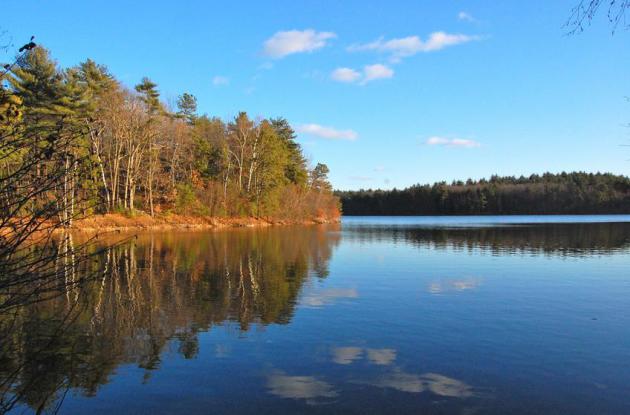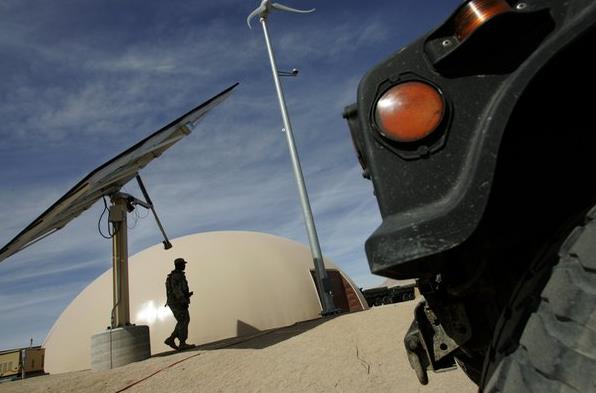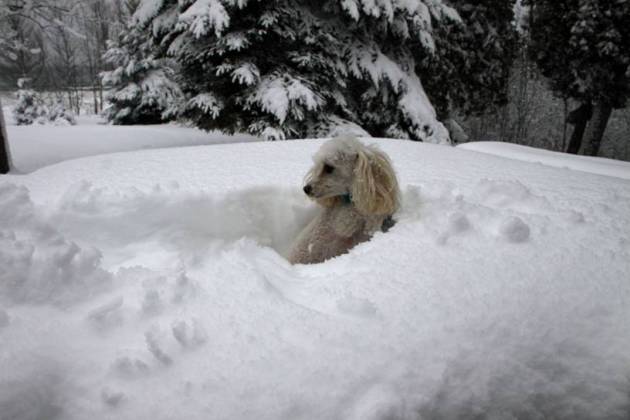Clipped Again
About
a foot of snow on the ground in the Twin Cities? Not bad, considering
most winters snow lovers have to beg & plead for a little "white
stuff". Even if a parade of Alberta Clippers means we're seeing snow an
inch or two at a time. The same persistently cold flow out of Canada
responsible for a numbing January is shutting out deep moisture from the
Gulf of Mexico.
For us to get walloped with heavy snow (6 to 20
inches) usually requires a southern storm track, from Kansas City to
Waterloo to Eau Claire, with just the right mix of southern-wet and
northern chill. I don't see that scenario playing out into at least the
first week of February.
The latest entry in our treadmill of
clippers drops a few inches of fluff this morning, enough snow to grease
up area highways. Circle your calendar: the mercury SOARS into the 30s
Sunday, before Canada goes on the attack again next week, highs blipping
just above zero Tuesday, again next weekend. Not as polar as January
6-7.
Finally, Jeff Masters at Weather Underground reports a record
41 separate billion dollar plus weather disasters, worldwide, in 2013.
The USA experienced 7 of those; not as many as 2010-2012. Check the blog
below for more details.
* for the latest advisories, watches and warnings for the Upper Midwest
click here, graphics courtesy of Ham Weather.
Inch or Two.
Notice the gap in the predicted stripe of snow from this morning's
fast-moving clipper. No idea what's happening there. But an inch or two
of fluff seems reasonable, most of it falling before noon today; travel
conditions improving into the afternoon. NAM data: NOAA and Ham Weather.
More Downs Than Ups.
After peaking in the 30s Sunday a series of Canadian cold waves lap
south of the border, coming in waves, like the ocean breaking on a sandy
beach. Let me ponder that image for a few seconds. OK. Better. Tuesday
and Thursday morning appear to the coldest mornings next week; an even
stronger surge of arctic air arrives a week from Sunday, when highs may
hold around -5F in the metro. Not quite as cold as January 6-7, but in
the same ballpark. Graphic: Weatherspark.
Holding Pattern.
The jet stream has become locked in a pattern that favors warm, dry
weather for the western USA, and colder than average weather from the
Upper Midwest into the Great Lakes and New England, a persistent
northwest flow east of the Rockies limiting how much moisture can bubble
out of the Gulf of Mexico. The solid red line shows the 32F isotherm,
pushing as far south as the Florida Panhandle.
Cold, But Not Quite Polar.
Next week's shot will be cold enough to definitely get your attention,
but not the school-closing cold of January 6-7. Graphic and information
above courtesy of NOAA.
Temperature Anomalies Next Wednesday.
Here is GFS guidance from NOAA, displayed on a very nice base map from
Climate Reanalyzer, showing temperature departurnes from the 1979-2000
normals. You can't miss the big cold bulls-eye from the Upper Midwest
into the Great Lakes, New England and Ohio Valley, temperatures as much
as 15-28F colder than average for late January. Meanwhile Alaska,
western Canada, Greenland and a big chunk of Europe and Asia are
forecast to be considerably warmer than average. Whatever happened to
average?
A January To Remember. Or Perhaps Forget. Here's an excerpt of a recent post from one of our weather partners,
Planalytics: "...
Over
the next two weeks, another round of arctic cold temperatures will
invade the Central Plains and Midwest as well as the Mid-Atlantic,
Northeast, New England, and Eastern Canada regions. Temperatures will
likely not trend as cold as earlier in the month; however, they will be
well below normal, with single-digit lows expected in the major cities
such as New York, Boston, and Philadelphia. Overnight lows in the
Midwest, Interior Northeast, and Eastern Canada can drop below 0°F over
the next two weeks. Freezing temperatures are expected to dip into the
Southeast, including Florida..."
Billion Dollar Global Weather Disasters In 2013 - Another One Brewing For California in 2014? In today's edition of
Climate Matters
we take a look at Aon Benfield's new report, showing a record 41
billion-dollar-plus weather disasters, worldwide, last year. Jeff
Masters has a terrific post at Weather Underground. Four countries
experienced the most expensive weather disasters in their recorded
history, including Germany, Philippines, New Zealand and Cambodia. If
the dry pattern doesn't break, very soon, California and much of the
west may be facing a billion dollar drought in 2014. Let's hope the
pattern shifts, and quickly.
California In "Drought State of Emergency", Governor Brown Declares. Here's a clip from a story at
ktla.com: "
California
Gov. Jerry Brown declared a “drought state of emergency” on Friday due
to ongoing water shortfalls following the driest calendar year in state
history. The governor said the state was facing perhaps the worst
drought since records have been kept. “We can’t make it rain, but we can
be much better prepared for the terrible consequences that California’s
drought now threatens, including dramatically less water for our farms
and communities and increased fires in both urban and rural areas,”
Brown said. “I’ve declared this emergency and I’m calling all
Californians to conserve water in every way possible...”
Photo credit above: "
Gov.
Jerry Brown points to images showing the snow depth in the Sierra
mountains on Jan. 13, 2013, left, and Jan. 13, 2014, center, while
declaring a drought state of emergency in San Francisco, Friday, Jan.
17, 2014. With a record-dry year, reservoir levels under strain and no
rain in the forecast, California Gov. Jerry Brown formally proclaimed
the state in a drought Friday, confirming what many already knew. Brown
made the announcement in San Francisco amid increasing pressure in
recent weeks from the state's lawmakers, including Democratic Sen.
Dianne Feinstein." (AP Photo/Jeff Chiu)
The Great Western Drought of 2014?
It's still early, and the rains may finally come in late January and
February, but considering 2013 was the driest year for California in 160
years of record-keeping, and snowpack is 10-20% of normal in the Sierra
Nevada, the stage is set for possible water shortages and more
brushfires than average later this year. Photo:
Twitter, Bay Area National Weather Service and Jason Liske.
What Californians Can Expect From The Drought. Picking up on the unusually warm, dry pattern enveloping much of the west,
Peter Gleick has a prediction of how a deepening drought will impact consumers and farmers in 2014; here's an excerpt: "...
Based on past experience, here is (part of) what Californians can expect this year if it remains as dry as it is now.
1.
Urban water agencies will (and are beginning to) roll out a wide range
of voluntary and mandatory water “conservation” programs. These
typically ask customers to limit discretionary water uses such as
watering gardens and washing cars and sidewalks. As droughts worsen,
agencies expand these programs to offer incentives for both structural
and behavioral changes: purchase more water-efficient appliances, remove
grass and plant water-efficient gardens, cut shower times, and more. In
the past, these kinds of programs and educational efforts have
temporarily cut urban water use by between 10 and 25% depending on the
programs and level of effort.
2. Some farmers and water
districts with “junior” water rights will see water allocations from
state and federal irrigation projects severely cut; some growers with
“senior” water rights will see modest or even no shortages at all..."
Earth's Record 41 Billion-Dollar Weather Disasters of 2013. Meteorologist Jeff Masters has another eye-opening post at
Weather Underground; here's the intro: "
Earth set a new record for billion-dollar weather disasters in 2013 with 41, said insurance broker Aon Benfield in their Annual Global Climate and Catastrophe Report
issued this week. Despite the record number of billion-dollar
disasters, weather-related natural disaster losses (excluding
earthquakes) were only slightly above average in 2013, and well below
what occurred in 2012. That's because 2013 lacked a U.S. mega-disaster
like Hurricane Sandy ($65 billion in damage) or the 2012 drought ($30
billion in damage.) The most expensive global disaster of 2013 was the
June flood in Central Europe, which cost $22 billion. The deadliest
disaster was Super Typhoon Haiyan, which killed about 8,000 people in
the Philippines..."
Graphic credit: Weather Underground, data source: Aon Benfield.
2013 To Be Among The Top 10 Warmest Years On Record According To World Meteorological Organization. Here's an excerpt from Stoke Sentinel: "Experts
have blamed high temperatures on man-made climate change stating that
2013 will be among the top 10 warmest on record. The World
Meteorological Organization made the claim stating that 'new record
high' sea levels are already making coastal populations more vulnerable
to storm surges. A spokesman from the Intergovernmental Panel on Climate
Change (IPCC) said: “All of the warmest years have been since 1998, and
this year once again continues the underlying, long-term trend. The
coldest years now are warmer than the hottest years before 1998..." (Image: NASA).
Armed Forces See Rise In Renewable Energy.
To appease Al Gore? Probably not. To save money, build in redundancy
and resiliency, and become less dependend on oil supply lines. Probably
because it makes dollars and sense and lowers the risk to our troops
deployed in the field, worldwide. Here's an excerpt from The Los Angeles Times: "The
use of clean energy technology has seen a sharp rise in military sites
in the U.S., as the armed forces push into green sources of power around
the country, a report said. The Army, Navy, Air Force and Marine Corps. have looked for ways to reduce its energy bills in recent years even as the Pentagon's budget is squeezed. Combined, the U.S. military
goes through $4 billion worth of power on its bases, according to a
report from Pew Charitable Trusts. The armed forces have moved to
quickly adopt green energy solutions, the report said..."
Image credit above: "
The armed forces are increasing their use of renewable-energy projects to cut down on power bills."
(Bob Chamberlin / Los Angeles Times / February 27, 2009).
50 Years Of Smoking In 2 Charts. Bloomberg Businessweek has the story; here's the introduction: "In
view of the continuing and mounting evidence from many sources, it is
the judgment of the Committee that cigarette smoking contributes
substantially to mortality from certain specific diseases and to the
overall death rate. Those words are from the surgeon general’s 1964 report (pdf) that marked the start of America’s battle against smoking. The White House releases the latest edition of the report on Jan. 17..."
Google's Smart Contact Lens: What It Does And How It Works. Wait, they want me to put this contraption next to my eyeball?
The Washington Post has the article and video; here's a clip: "...
The
soft contact lens that Google’s is introducing — it’s still just a
prototype — houses a sensor between two layers of lenses that measures
the glucose levels in tears. The lens also features a small — really
small — antenna, capacitor and controller, so that the information
gathered from the lens can move from your eye to a device where that
data can be read and analyzed..."
The Weirdest Interview Questions Hiring Managers Ask. Some of these are truly bizarre - here are a couple of clips from a story at
Fast Company: "
Glassdoor on Friday released its list of the top 25 oddball interview questions,
which were compiled by its data science team based on tags and
community feedback. While the list is tech-heavy, it's not just Silicon
Valley that's fond of brainteasers...Glassdoor's full list is below:
- “If
you could throw a parade of any caliber through the Zappos office, what
type of parade would it be?” --The Zappos Family, Customer Loyalty Team
Member interview.
- “How lucky are you and why?” --Airbnb, Content Manager interview.
- “If you were a pizza delivery man, how would you benefit from scissors?” --Apple, Specialist interview.
- “If you could sing one song on American Idol, what would it be?” --Red Frog Events, Event Coordinator interview...."
Climate Stories....
Global Warming Denial Hits A 6-Year High. Chris Mooney has the details in a story at
Mother Jones; here's an excerpt: "...
The latest data
are out on the prevalence of global warming denial among the US public.
And they aren't pretty. The new study, from the Yale and George Mason
research teams on climate change communication, shows a
7-percentage-point increase in the proportion of Americans who say they
do not believe that global warming is happening. And that's just since
the spring of 2013. The number is now 23 percent; back at the start of
last year, it was 16 percent..."
Image credit above: "
The increase in climate science disbelief. Yale and George Mason University teams on Climate Change Communication.
Belief In Climate Change Depends On The Weather. At least among Independent voters.
The Week has the story; here's a clip: "
Conservative organizations spend as much as a billion dollars a year trying to convince Americans that climate change isn’t real, or if it is real, that it isn’t caused by humans. At one point, it seemed that their campaign was working. In 2009, Pew found
that belief in global warming had fallen to a low of 59 percent, down
from 77 percent in 2007. And just 36 percent of those surveyed that year
believed that climate change was being caused by humans, down from 47
percent in 2007. However since 2009, the number of believers has grown:
Today 69 percent of those surveyed believe global warming is occurring,
with 42 percent believing it is caused by humans..."
Climate Change On Walden Pond.
I wonder if Thoreau would accept or deny the science if he was still
around? Here's an interesting nugget from Dr. Mark Seeley's
always-enjoyable
WeatherTalk Newsletter:
"A recent paper published in the New Phytologist by research biologists
at Boston University shows that trees and shrubs of Walden Pond leaf
out about 18 days earlier than they did when Henry David Thoreau made
his observations there in the 1850s. This is a measure of climate change
for the Concord, MA area. You can read more about this study and what
it means for invasive species at...
http://www.sciencedaily.com/releases/2014/01/140113114756.htm
Photo credit above: Wikipedia.
U.S. Army Colonel: World Is Sleepwalking To A Global Energy Crisis.
Alarmist hype? Do we have enough oil, especially shale oil, to not have
to breathe another word of "peak oil" for a few more decades? I don't
pretend to know the answer to that, but here's an excerpt of a story at
The Guardian that caught my eye: "...
Lewis
told participants that the International Energy Agency's (IEA) own
"comprehensive" analysis in its World Energy Outlook of the 1,600 fields
providing 70% of today's global oil supply, show "an observed decline
rate of 6.2%" - double the IEA's stated estimate of future decline rate
out to 2035 of about 3%. The IEA report also shows that despite oil
industry investment trebling in real terms since 2000 (an increase of
around 200-300%), this has translated into an oil supply increase of
just 12%. Lewis said:
"That is a very striking
number and one I think that should be ringing alarm bells. It indicates
to me that something has fundamentally changed in the economics of the
oil industry and that you're having to invest more and more for
diminishing incremental production."
